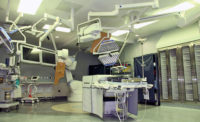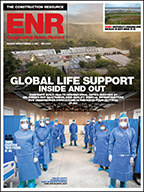Health care remains one of the region’s stronger markets, with new projects starting up now that some of the uncertainty surrounding national health-care reform has abated.
“The Southeast has more work in the health-care sector than other parts of the country,” says Mike Noli, president of NoliWhite Group of Brentwood, Tenn. “And it’s stronger than commercial or residential.”
NoliWhite is building the $109-million, 245,000-sq-ft John D. Archbold Memorial Hospital’s new North Tower in Thomasville, Ga. The 112-bed, eight-story project is the last component of a multiphased modernization initiative.
“We have a lot of health-care work,” adds Dave Johnson of Perkins+Will in Atlanta. “There is a lot of pent-up demand.”
Alan Scoggins, senior vice president for Skanska USA Building’s Healthcare division in Atlanta, says his firm is seeing smaller projects and renovations because hospitals continue to worry about increasing numbers of unemployed patients without insurance.
Skanska recently completed a $6.9-million ICU addition and renovation at Coliseum Medical Center in Macon, Ga., and a $5-million stroke and neuroscience center for Grady Hospital in Atlanta.
Skanska started a few major projects during the recession, including the $380-million Nemours Children’s Hospital in Orlando, which broke ground in June 2009 and topped out in August. The 630,000-sq-ft facility is scheduled for a 2012 finish.
The company also has started work on a $75-million, 400,000-sq-ft bed tower and medical office building at St. Francis Hospital in Columbus, Ga.
Johnson adds that although there are fears about the economy, those institutions with the financial resources are moving ahead with construction plans, and they’re paying about 15% less than they would have a couple of years ago.
Perkins+Will designed the $260-million, 620,000-sq-ft, seven-story Duke Medicine Pavilion in Durham, N.C., which will have 160 ICU beds in six units; 18 additional operating rooms; 20 imaging rooms; and 20,000 sq ft of medical research space.
BE&K Building Group of Charlotte, N.C., is building the hospital expansion, scheduled for completion in 2013, as well as the Duke Cancer Center, a seven-story facility to house its comprehensive oncology programs.
James A. Brownrigg, vice president and director of health care for Turner Healthcare in Brentwood, Tenn., says Florida has been a relatively busy market.
Turner is in preconstruction on an expansion project at Miami Children’s Hospital and building a portion of the new Orlando VA Medical Center. In Georgia, the company is working on the design and construction of a new $333-million, 745,000-sq-ft hospital at Fort Benning, Ga., for the U.S. Army Corps of Engineers, Savannah District. Designed by Ellerbe Becket of Washington, D.C., the Martin Army Community Hospital will have 70 beds and parking for 2,000 vehicles. The team aims for LEED-Silver certification.
Financial and Federal Effects
The bond market has improved, and hospitals are having an easier time securing money.
“The double impact of the financial crisis and the credit tightening and the economic conditions created a bigger slump to health-care capital development than you would typically see during a recessionary period,” Brownrigg says. “That market begin returning in late 2009.”
Maintenance work is moving forward as are some ambulatory facilities, which are less costly to build.
“We’re expecting to see more of that due to health-care reform,” Adams says. The act includes an emphasis on primary care and medical homes.









Post a comment to this article
Report Abusive Comment